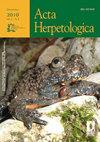濒危两栖动物鲁里斯坦蝾螈的描述骨学(Neurergus kaiseri,两栖纲:蝾螈科)
IF 0.9
4区 生物学
Q4 ZOOLOGY
引用次数: 2
摘要
骨结构是重要的生物学特征,它提供了有价值的生物学和生态学信息。鲁里斯坦蝾螈(Neurergus kaiseri)是一种特有的蝾螈,栖息在伊朗扎格罗斯山脉南部。目前的研究是为了描述鲁里斯坦蝾螈的骨学特征,这可能对理解蝾螈物种的进化过程很重要。凯塞里猪笼草的头骨结构致密,骨质严重,软骨成分含量较低,仅在活动面。该物种轴向骨骼中的脊椎数量等于50。脊柱的颈部、腹部和尾部分别有两块、16块和32块椎骨。每只手和脚由四个手指组成,有三到四个指骨。掌骨包括七块骨头,跖骨的数量为八块。手通过尺骨和桡骨与人类相连,然后与舟珊瑚相连。每条腿包括两块与股骨相连的骨头(腓骨和胫骨)。股骨头部与骨盆中的髋臼关节连接,而股骨远端与胫骨关节连接。本文章由计算机程序翻译,如有差异,请以英文原文为准。
Descriptive osteology of an imperiled amphibian, the Luristan newt (Neurergus kaiseri, Amphibia: Salamandridae)
Osteological structures are important biological features which provide valuable biological and ecological information. Luristan newt ( Neurergus kaiseri ), is an endemic salamander, inhabiting the southern part of Zagros Mountains of Iran. The current study was conducted to describe the osteological characteristics of the Luristan newt which might be important in understanding the evolutionary process of newt species. The skull of N. kaiseri has a dense structure, severely ossified elements and a low amount of cartilaginous elements, only in mobile facets. Vertebral number in the axial skeleton of the species equals 50. The cervical, abdominal and caudal parts of the vertebral column have two, 16 and 32 vertebrae, respectively. Each hand and foot consisted of four fingers, having three or four phalanxes. The metacarpal includes seven bones and the number of metatarsus bones is eight. Hands are connected to humur through ulnare and radius and then connected to scapulocoracoid. Each leg includes two bones (fibula and tibia) which are connected to femur. The head of the femur articulates with the acetabulum in the pelvic bone, while the distal part of the femur articulates with the tibia.
求助全文
通过发布文献求助,成功后即可免费获取论文全文。
去求助
来源期刊

Acta Herpetologica
ZOOLOGY-
CiteScore
1.20
自引率
12.50%
发文量
10
审稿时长
6 months
期刊介绍:
Acta Herpetologica, a journal open to academics all over the world, offers itself as a new site for the presentation and discussion of the most recent results in the field of research on Amphibians and Reptiles, both living and extinct. The official journal of the Societas Herpetologica Italica (S.H.I.), Acta Herpetologica publishes original works – extended articles, short notes and book reviews – mostly in English, dealing with the biology and diversity of Amphibians and Reptiles.
 求助内容:
求助内容: 应助结果提醒方式:
应助结果提醒方式:


